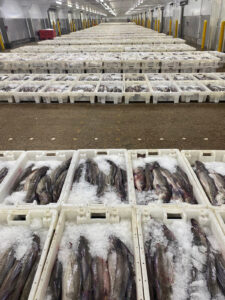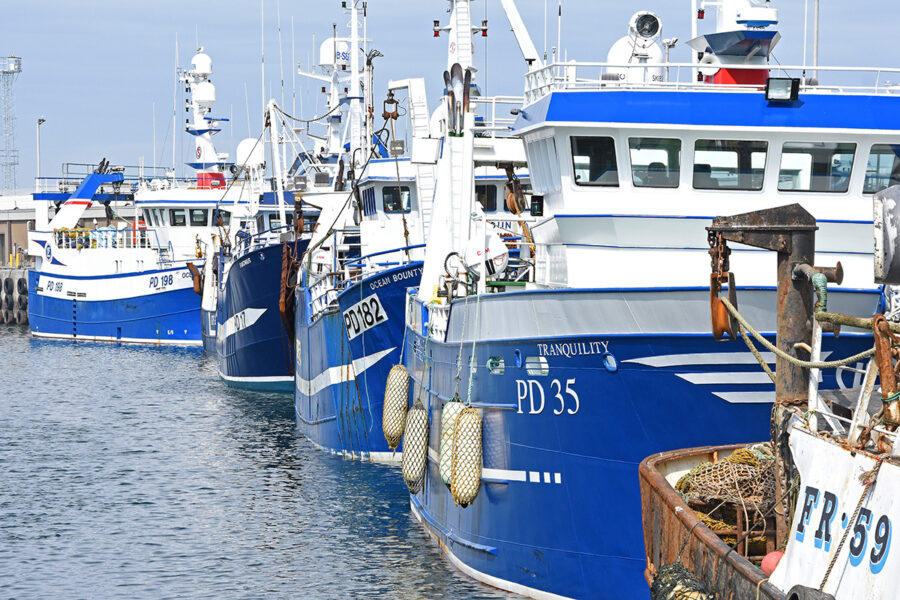Scientific advice for 2023 catches is for significant increases of some key northern area species, with many recommendations confirming what fishermen have been reporting across the grounds for the last 12 months, reports Tim Oliver. The advice for North Sea cod is for a catch of 22,946t – a 44% increase.
Welcome as this recommended increase is, it comes against a background of three years of cuts that mean the 2023 TAC is still likely to be some way out of line with the abundance skippers continue to experience on the grounds.
A huge increase of 160% is recommended for northern shelf haddock. ICES says the 2019 and 2020 year-classes for the stock are the largest since 1999, reflecting the huge run of small haddock that has been abundant both inshore and offshore. Much of this has been left uncaught, due to poor prices for these smaller fish, with skippers steaming further offshore in a bid to find a larger run of fish. The TAC advice may yet be updated in November.
North Sea whiting is in line for a recommended 314% increase, with an advised catch of 110,172t. This stock has also seen good year-classes in 2019 and 2020.
Northern demersal vessels should also benefit from advised increases in northern shelf saithe (19%) – quotas of which have been under pressure, after further showing of fish across the board this year – and for hake (5%).
On the west coast of Scotland, ICES is again advising a zero catch of cod, saying that recruitment and spawning stock biomass continue to be very low. Advice, however, suggests that northern inshore and offshore populations could be linked to northwest North Sea cod stocks – something skippers also believe, as they are finding abundant cod on the north coast in particular, with skippers continuing to expend time and energy in avoiding large shots.
The Clyde cod saga seems set to continue, with all the ramifications for the Clyde fishing fleet, after a year of knee-jerk management and closures. The advice given was that this is likely to be a separate sub-population, possibly linked to the Irish Sea stock. A lack of data means that little firm advice is available, meaning that no decisions for 2023 can yet be made.
An increase of 131% is advised for west of Scotland whiting, and a small decrease is advised for west coast and northern North Sea megrim of -2%.
In the southern North Sea, where the majority of flatfish stocks are, advice is mixed. An increase of 5.8% is recommended for North Sea plaice, with the spawning stock biomass increasing after several years of decline. Recommended cuts of 40% in North Sea sole, with an advised catch of 9,152t, reflect continuing catch reports from much of the fleet on the English east coast, where sole continues to be largely absent, with recovery from pulse fishing being hampered by dredge spoils, aggregate dredging and other activities.
ICES will provide further advice in the autumn on Rockall megrim, monkfish, North Sea and west coast Nephrops, ling and witches, and on most of the main pelagic stocks (blue whiting, Atlanto-Scandian herring, mackerel and horse mackerel).
Qualified welcome

Reflecting reports from skippers across the North East, Peterhead merchant Graeme Tallis last week posted this picture of haddock landed by the Venture BF 236, which he described as the ‘best shot of haddock I’ve seen in years’. North East fishermen may be worried about fuel prices, and the capacity of fish processors that are facing continued labour shortages – but the fish themselves seem to be doing just fine.
Scottish industry leaders gave a qualified welcome to the advice for the increase in 2023 TACs, but expressed reservations that despite the increase in the cod TAC, it was a rise from a very low level after a number of years of cuts.
Mike Park, chief executive of the Scottish White Fish Producers’ Association, said he was pleased by the suggested increases in the TACs, but expressed concern at scientists’ delay in recognising increases in stocks. He said Scottish skippers had been reporting ‘almost a mini-gadoid outburst’ in the North Sea, similar to the unexplained explosion of North Sea whitefish stocks that was experienced in the 1970s.
“The disappointing element for us is that the science always seems to identify an increase a year after the fishermen do,” he told Fishing News.
“So whereas we’re seeing an abundance on the grounds in terms of sizeable fish, it’s not coming out in the science and the TACs until the following year, which is always a negative for the fishermen.”
The increase of 44% in the cod TAC, while welcome, was an increase from a low level after three years of cuts, he said. “But it is definitely needed for next year, given the level of abundance we’re seeing on the grounds.”
There was also concern that there is no recommendation for an increase in the west of Scotland cod TAC. “We believe the west coast stock is aligned with the northern North Sea cod stock, and the scientists seem to be coming to terms with that as well,” said Mike Park
“North of the Butt of Lewis, and further north, fishermen are seeing high abundances of cod similar to what we’re seeing in the North Sea, which would lead you to think it’s one and the same stock. We’re hoping the benchmarking will pick that up next year, and we will see a TAC on the north end of the west coast of Scotland that recognises that increased biomass.
“Our fishermen are seeing high abundance and catchability of good-sized monks on the grounds. They are looking for an increase in the TAC, and it will be disappointing if that increase doesn’t come through.”
The Shetland Fishermen’s Association (SFA) also gave a qualified welcome to the recommended increases.
“A 44% increase in the North Sea cod quota, as recommended, would of course be good news, as would a 19% increase in saithe quota,” said SFA chairman James Anderson, skipper of the whitefish trawler Alison Kay.
“But we should not forget that steep cuts in quotas for species such as cod in recent years should never have happened in the first place. We have seen abundant cod and saithe on our grounds throughout a three-year period of sharply reduced quotas, and even with next year’s increases we will still be far from reversing that totally unnecessary damage.”
SFA executive officer Simon Collins said that the fishing industry was determined to co-operate with scientists to improve the quality of the data used in stock assessments. “The Northern Fishing Alliance, representing fishermen from the UK, Norway and Denmark, is already working with ICES on cod science, and will look to other species in the near future.
“We cannot continue to run our fisheries on the basis of patchy or non-existent data, and we intend to play a full part in remedying these deficiencies. Science that makes the best of fishermen’s knowledge is the only real guarantee of the sustainability of our fish stocks and the communities that depend on them.”
Managers ‘must take account of more than the science’
Scientists are due to brief industry representatives south of the border on the ICES advice for 2023 next week (19-20 July).
NFFO chief executive Barrie Deas said it was important to distinguish between the scientific advice and management decisions on the final TACs, with fishery managers having to take account of a broader range of factors, such as the socio- economic implications of changes in catch limits.
“Last year, TACs for whiting and haddock in particular were kept artificially low to reduce pressure on cod, because cod is deemed to be caught in association with these species, so the logic is you keep the TACs of these associated species down,” he said.
On the problem of the difference between the scientific advice and the experience of fishermen on the grounds, such as with North Sea cod, he said a proposal is now being written up to deal with these that will be ready for the next meeting in January of ICES and fisheries stakeholders.
“The idea is to scrutinise that handful of stocks where the industry view is completely different from the scientists. It doesn’t prejudge who’s right and who’s wrong – I think it’s a positive in a number of ways.
“Obviously it’s good to know from an industry point of view that the industry perception of the stock is being taken seriously.
“Also, the very fact that ICES is talking in these terms suggests that for most stocks for most of the time there is no controversy. It’s an important development, and it’s important that it does go through.”
This story was taken from the latest issue of Fishing News. For more up-to-date and in-depth reports on the UK and Irish commercial fishing sector, subscribe to Fishing News here or buy the latest single issue for just £3.30 here.








